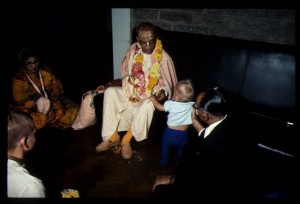CC Madhya 19.189 (1975)

A.C. Bhaktivedanta Swami Prabhupada
Below is the 1996 edition text, ready to be substituted with the 1975 one using the compile form.
TEXT 189
- śānta-bhakta—nava-yogendra, sanakādi āra
- dāsya-bhāva-bhakta—sarvatra sevaka apāra
SYNONYMS
śānta-bhakta—the neutral devotees; nava—nine; yogendra—saintly persons; sanaka-ādi āra—and the four Kumāras, headed by Sanaka; dāsya-bhāva-bhakta—devotees in dāsya-rasa; sarvatra sevaka apāra—similar innumerable servants everywhere.
TRANSLATION
“Examples of śānta-bhaktas are the nine Yogendras and the four Kumāras. Examples of devotees in dāsya-bhakti are innumerable, for such devotees exist everywhere.
PURPORT
The nine Yogendras are Kavi, Havi, Antarīkṣa, Prabuddha, Pippalāyana, Āvirhotra, Draviḍa (Drumila), Camasa and Karabhājana. The four Kumāras are Sanaka, Sanandana, Sanat-kumāra and Sanātana. The servant devotees in Gokula are Raktaka, Citraka, Patraka and so on. In Dvārakā there are servants like Dāruka, and in the Lord’s pastimes in the material world there are servants like Hanumān.